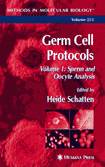|
|
|
| |
 |
|
|

|
 推薦指數:
推薦指數:





|
|
- 內容介紹
|
Germ Cell Protocols
Volume 1: Sperm and Oocyte Analysis
Schatten, Heide (University of Missouri, Columbia, MO)
Binding: Hardcover
Pub. Date: March 2004
Pages: 336
ISBN: 1588291219
Abstract:
For volume 1 alone: A gold-standard collection of readily reproducible techniques for the molecular and genetic analysis of germ cells in a variety of different reproductive systems. Volume 1: Sperm and Oocyte Analysis focuses on sperm cells, oocyte analysis, oocyte maturation, fertilization, and preparation techniques. Highlights include in vitro maturation and fertilization of human, porcine, and canine oocytes; the cryopreservation of sperm cells; establishment of an in vitro spermatogenesis system; visualization of sperm accessory structures; and motility assays of stallion spermatozoa. Each readily reproducible protocol is described in step-by-step detail and contains an introduction outlining the principle behind the technique, lists of equipment and reagents, and tips on troubleshooting and avoiding known pitfalls. For both volumes: A gold-standard collection of readily reproducible techniques for the molecular and genetic analysis of germ cells in a variety of different reproductive systems. The methods cover sperm and egg activation, motility, fertilization, nuclear development, nuclear cloning, the molecular characterization of specific events, and the imaging of cell structures. Volume 1: Sperm and Oocyte Analysis focuses on sperm cells, oocyte analysis, oocyte maturation, fertilization, and preparation techniques. Volume 2: Molecular Embryo Analysis, Live Imaging, Transgenesis, and Cloning contains methods for molecular egg analysis, live egg imaging, nuclear cloning, oocyte preservation, and nuclear transfer. Comprehensive and cutting-edge, Germ Cell Protocols offers both novice and established researchers a gold-standard collection of hard-to-find methods of high impact research, diverse procedures that are easy-to-follow, well-illustrated, and allow a cross-species transfer of knowledge from lower vertebrates to higher mammalian systems.
|
|
|

